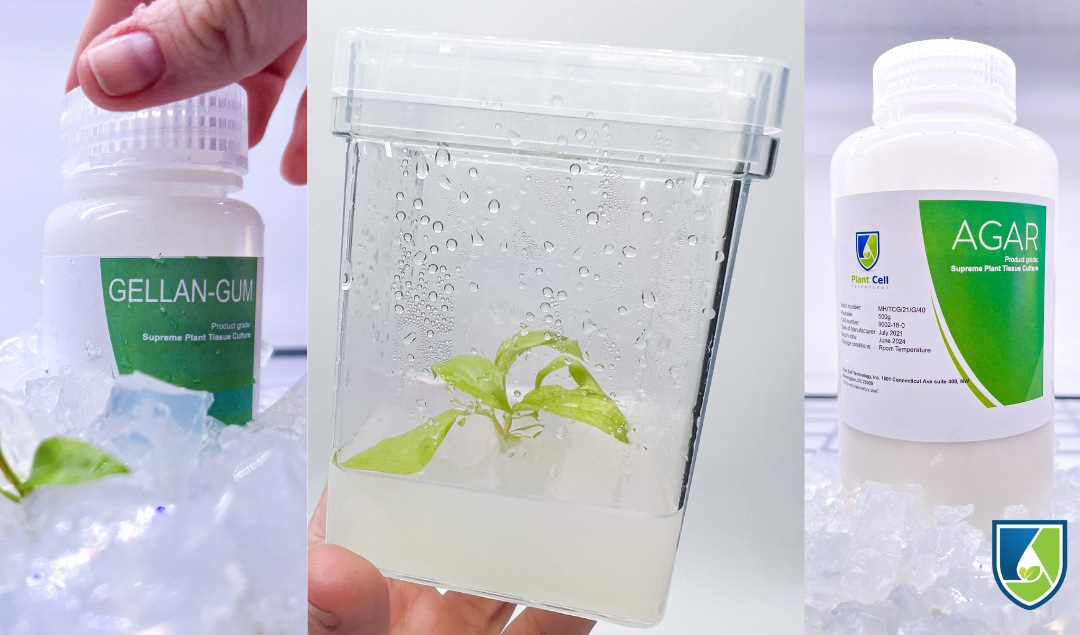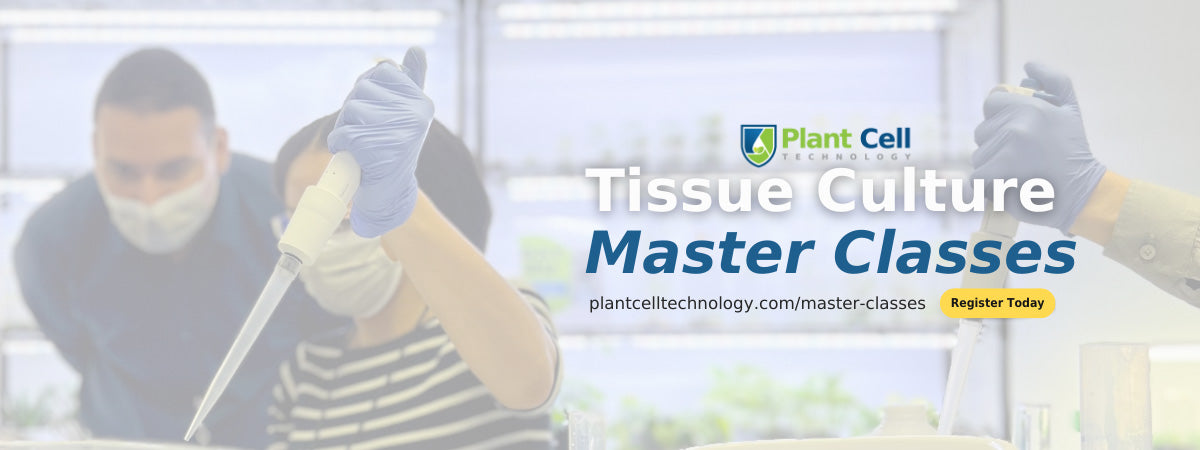
Gelling Agents - What To Look For?
As a content and community manager, I leverage my expertise in plant biotechnology, passion for tissue culture, and writing skills to create compelling articles, simplifying intricate scientific concepts, and address your inquiries. As a dedicated science communicator, I strive to spark curiosity and foster a love for science in my audience.


Gelling agents are simply materials that have a gelling (or gel forming) property. When dissolved in a liquid phase, they form a colloidal mixture with a weakly cohesive internal structure, resulting in gel formation.
Overview
What on earth would you need a gelling agent for? Well, if you are looking to formulate either semisolid or solid media, then you will need a gelling medium.
Gelling agents are simply materials that have a gelling (or gel forming) property. When dissolved in a liquid phase, they form a colloidal mixture with a weakly cohesive internal structure, resulting in gel formation. These agents can be organic hydrocolloids or hydrophilic inorganic substances. In the formulation of semisolid dosage forms, gelling agents are typically used at concentrations ranging from 0.5% to 10%. Some examples of gelling agents include tragacanth, pectin, sodium alginate, agar, gelatin, cellulose derivatives, and clays.

Figure: Timeline of the discovery of different gelling agents.
The very first gelling medium that was discovered was gelatin and today we see it is used throughout the food industry. However, it may not be your best option for tissue culture and other in vitro practices. Agar is another popular and well-known gelling agent, especially amongst vegetarian baking enthusiasts, and researchers are enjoying it as a successful agent for in vitro experiments.
There are a variety of other gelling agents available, from xanthan gum to isabgol, and it can be challenging to know what the best gelling agent is to use for your tissue culture. Not all gelling agents will deliver the same result and fulfill your purpose.
The exponential development of the cannabis and other plant markets are setting the stage for further research into efficient cultivation techniques. Tissue culture looks set to be the future of cannabis cloning and other ornamental and horticulturally important plants, and agar could be one of the most exploited gelling agent for the tissue culture processes.
This article explores more about the characteristics of the solidifying agents, such as agar and gellan gum to help you decide which one's perfect for your tissue culture procedures. Let's begin!

How Gelling Agents Work?
When gelling agents are dissolved in a liquid, they interact with the surrounding molecules to create a network-like structure. This network entraps the liquid within it, resulting in the formation of a gel. The cohesive forces between the gelling agent molecules contribute to the gel's stability and ability to maintain its shape.
The specific mechanism of gelation varies depending on the type of gelling agent used, but overall, it involves the aggregation or cross-linking of molecules to form the gel structure.
Characteristics of The Solidifying Agents
Let's take a step back. If we are to understand what to look for in a gelling agent, then we need to know how they work. Firstly, the gelling agent will be added to the liquid plant media. This will cause the liquid MS media (or any other growth media) to be converted into semi-solid or solid media. the solidifying agents used in the applications cab be manufactured by using proteins, from both microbial and plant sources, and colloidal polysaccharides.
These proteins and polysaccharides form continuous three-dimensional molecular networks, and this is what causes them to act as solidifiers. However, even in these cases, extra firmness may be required. This is where gelling agents come into play; agents such as agar firm the medium and helps to mold some of the medium's essential characteristics such as the diffusion characteristics.
The medium's viscosity will be the primary determinator for the rate of diffusion. And what determines the viscosity? Well, that would be the physicochemical characteristics and concentration of the agent that you use. Some gelling agents are highly temperature-sensitive and can go between states of gel and liquid, according to the temperature. This flexibility is often a sign of an excellent gelling agent.

Other characteristics to look for in a gelling agent:
- Colorless or transparent
- Odorless
- Able to retain moisture well
Each individual gelling agent will have a unique pH profile and protocols to follow, such as ideal temperature and methods for use. While each gelling agent is unique, there are a few tips that can be applied across the board:
Clumping
Do you want to avoid clumping in your medium? Of course, you do! To prevent clumping, be mindful of how you add the gelling agent to the dispersing medium. Avoid haphazardly mixing the agent in as this can cause clumping. When clumping occurs, it means that the gelling agent's outer molecules become hydrated with the medium, and a surface layer forms, preventing the medium from penetrating and mixing efficiently with the agent. In time the clumps may eventually dissolve, but it is timely and can be avoided if a sieve is used and care is taken when the agent is added. Gently stir the agent into the medium while sieving, and you could even use a wetting agent in the form of a small amount of glycerine to prevent clumps from forming.
Consider the Water Temperature
Are you using hot or cold water? Agents such as poloxamers and methylcellulose are more soluble in cold water. Agents such as bentonite, sodium carboxymethyl cellulose, gelatin, and agar require hot water. Warm or tepid water is necessary for alginic acid agents, carbomers, and tragacanthin agents.

Be Mindful of the pH Level
If you are using an agent such as a carbomer, you will be required to use a type of neutralizer to adjust the ph manually. This neutralization will help to form the gel consistency after the agent has been added to the medium.
Be Patient
You will need to be patient as the majority of gelling agents will need to have at least 24 hours to become fully hydrated, clear and viscous.
Be Precise with Measurements
How much are you using? Be sure to know the exact amount needed. The majority of gelling agents will require a concentration between 0.5 and 10 %. This is quite a difference, so be sure to check the exact concentration beforehand.
Agar: Cannabis' favorite gelling agent
One of the most popular gelling agents for cannabis tissue culture procedures is agar. Agar originates from a specific type of seaweed and is therefore considered to be a natural gelling agent. The agar used as a gelling agent is derived from a particular species of red seaweeds, namely Gellidium and Gracillaria. While both genera can be used, the strongest and firmest gelling agents are derived from Gellidium as it has a higher gel strength.
When you are deciding on a gelling agent, your primary concerns should be the agent's purity and quality. Here at Plant Cell Technology, we have included agar in our line of premium products, and you can find quality agar here for you to use as your gelling agent.
Plant Cell Technology Supplying The Most Cost-Effective and Quality Tissue Culture Products

Tissue culture is penetrating various plant industries, making it an essential technology for researchers to study plants, comprehend their behavior, grasp their working mechanisms, and conduct studies to find answers to numerous plant-related questions. Therefore, it is crucial for culturists worldwide to comprehend and engage with this technology. However, one major limitation of the expanded applications of tissue culture is the associated cost. We require cost-effective products that maintain their quality.
This is where Plant Cell Technology can help you achieve your goals. We have a one-stop shop for all your tissue culture needs, including MS Media, plant hormones, PPM, and solidifying agents. Whatever you need, we have it in our store!
Moreover, we are thrilled to offer hands-on training for individuals interested in learning this technique. Our master classes are designed to enhance your tissue culture skills and integrate them into your current growing facility. All our classes are led by tissue culture experts with over 10 years of hands-on experience.
It's a wonderful opportunity for anyone interested to elevate their knowledge directly from the experts, learning from their mistakes and years of hard work.
This just sounds perfect for you? So, why wait? Sign up HERE and we will see you at the class!
Blog Categories
View by Level
Popular Blogs

How Samantha Bridges the Gap Between the Nursery and the Lab
The Introduction Building a tissue culture program from the ground up requires more than just scientific knowledge—it requires the grit...
Read More
Understanding The Synthetic Seed Technology
Introduction Let’s be honest: traditional plant propagation can be a logistical nightmare. If you’re working with recalcitrant species—those stubborn plants...
Read MoreSubscribe to Our Newsletter








Join the conversation
Your email address will not be published. Required fields are marked